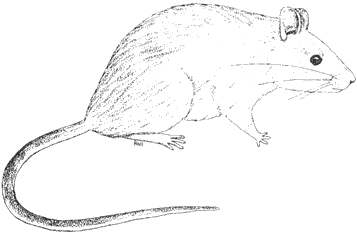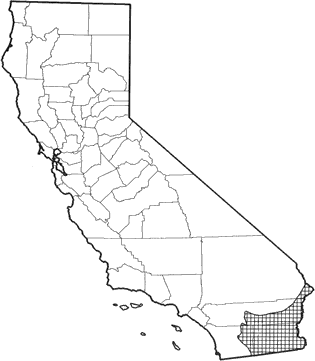
White-throated Woodrat
Distribution, Abundance, and Seasonality
The white-throated woodrat is found in extreme southeastern San Bernardino Co., central and eastern Riverside Co., eastern San Diego Co., and throughout Imperial Co. It is common in many desert habitats and in pinyon-juniper habitat. Distribution is influenced strongly by availability of den-building materials (Matson 1976). The northern and elevational limits of distribution may be influenced by its relatively low tolerance for cold temperatures (Brown 1968).

Range Map
Specific Habitat Requirements
Feeding: Eats mainly succulent plant material such as cacti, mesquite, and some yucca, but little or no grass or animal matter (Vorhies and Taylor 1940). In creosote mesquite habitat in New Mexico, the diet consisted mainly of yucca leaves, other green vegetation, and heads of composites (Wood 1969, Macedo and Mares 1988).
Cover: Dens are of 2 types. In rocky areas, plant litter is piled around a crevice; favored materials include litter of spiny plants (cholla, prickly pear, mesquite, and catclaw), probably because of the added protection from predators they afford. The nest itself is located in the rear of the crevice. Dens also may be constructed against, or beneath shrubs, preferably shrubs or cacti having much cover near the ground. Such dens can become quite large, reaching 1 m (3 ft) high and 3 m (10 ft) in diameter. A grassy nest is located below the ground surface in these dens.
Reproduction: Nests about 20 cm (8 in) in diameter are constructed of grasses and other soft plant material. The interior of the nest is hollowed out for occupancy (Vorhies and Taylor 1940, Turkowski and Watkins 1976).
Water: Water is obtained chiefly from succulent vegetation.
Pattern: Desert scrub with cacti or mesquite, with or without rock outcrops. The abundance of white-throated woodrats is correlated with the abundance of suitable shrubs for supporting dens (Vorhies and Taylor 1940, Turkowski and Watkins 1976).
Species Life History
Activity Patterns: Mainly nocturnal. Active yearlong.
Seasonal Movements / Migration: None.
Home Range: In New Mexico creosote and mesquite habitats, density averaged 0 to 2.5/ha (0 to 1/ac) (Wood 1969). Densities in pinyon-juniper woodland averaged 0.2 to 2.5/ha (0.1 to 1/ac) (Turkowski and Watkins 1976). In southeastern Arizona creosote flats, densities averaged 0 to 0.4/ha (0 to 0.16/ac) (Chew and Chew 1970).
Territory: White-throated woodrats are solitary and asocial.
Reproduction: Breeds from January into July in creosote-mesquite habitat in southern California (Schwartz and Bleich 1975). Litter size ranges from 1-3 young. Probably 2, if not 3, litters per yr (no data found). Weaning occurs at 27-40 days of age (Schwartz and Bleich 1975). Female may reproduce at 80-87 days males by 100 days of age.
Niche: Predators include coyotes, ringtails, bobcats, foxes, hawks, owls, and snakes. Woodrat dens are frequented by a variety of arthropods, and some white-throated woodrats are parasitized by bot fly larvae, fleas, and blood-sucking assassin bugs.
Sources & References
California Department of Fish and Game, 1999.
California's Wildlife, Sacramento, CA.
Written by: P. Brylski, reviewed by: H. Shellhammer, edited by: R. Duke
Brown, J. H. 1968. Adaptation to environmental temperature in two species of woodrats, Neotoma albigula. Univ. Mich. Mus. Zool., Misc. Publ. No. 135. 48pp. Chew, R. M., and A. E. Chew. 1970. Energy relationships of the mammals of a desert shrub (Larrea tridentata) community. Ecol. Mongr. 40:1-21. Macedo, R. H., and M. A. Mares. 1988. Neotoma albigula. Mammal. Species No. 310. 7pp. Matson, J. O. 1976. The distribution of rodents in Owens lake region, Inyo Co. Calif. Nat. Hist. Mus. Los Angeles Co., Sci. Contrib. No. 276. 27pp. Schwartz, O. A., and V. C. Bleich. 1975. Comparative growth in two species of woodrats, Neotoma lepida intermedia and Neotoma albigula venusta. J. Mammal. 56:653-666. Turkowski, F. J., and R. K. Watkins. 1976. White-throated woodrat (Neotoma albigula) habitat relations in modified pinon-juniper woodland in southwestern New Mexico. J. Mammal. 57:586-591. Vorhies, C. T., and W. P. Taylor. 1940. Life history and ecology of the white-throated woodrat, Neotoma albigula albigula Hartley, in relation to grazing in Arizona. Univ. Ariz. Agric. Exp. Sta. Tech. Bull. 86:453-529. Wood, J. E. 1969. Rodent populations and their impact on desert rangelands. New Mexico State Univ. Agric. Exp. Stat. Bull. No. 555. 17pp.
California Animal Facts | California's Wildlife